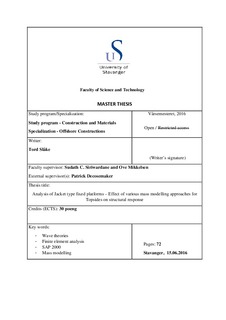| dc.contributor.author | Slåke, Tord | |
| dc.date.accessioned | 2016-09-28T13:51:46Z | |
| dc.date.available | 2016-09-28T13:51:46Z | |
| dc.date.issued | 2016-06-15 | |
| dc.identifier.uri | http://hdl.handle.net/11250/2411491 | |
| dc.description | Master's thesis in Offshore structural engineering | nb_NO |
| dc.description.abstract | A fixed platform in shallow waters is supported on a Jacket structure with a heavy Topside over it.
The Jacket design is designed for various limit states including the ultimate limit state (ULS),
serviceability limit state (SLS) and the fatigue limit state (FLS). The loading on a Jacket is generally
the environmental loading and gravity loads. The environmental loads are wind, wave and current
loading. The wave loading is generally governing and wave theory used in analysis need to be
chosen carefully. The gravity loads are from the overhead Topside in addition to self-weight of the
Jacket. It is observed in some cases that while the Jacket design is completed, the Topsides work
including some part on the design is not completed. Also many a times the Topside and Jacket
design contracts are given out to separate engineering contractors depending on their expertise and
specialized experience. For Jacket contractors, it becomes not only impractical but also
uneconomical to spend hundreds of hours on modelling the Topside in minute detail. In such cases
it is very important to represent the Topside mass precisely for the Jacket design.
However, not many guidelines are available on the mass modelling approaches to be adopted for
Topside modelling in cases where limited information and time is available. Various approaches
of modelling the Topside mass are formulated and discussed in this thesis. These approaches are
first demonstrated on a simple structure. The approaches are then used for a case study on one of
the heaviest offshore structure in the Norwegian Continental Shelfs (NCS). The Topside has a
weight of 28000 tons in this case. The results using various approaches are presented and
conclusions are drawn. In the end, recommendations are made for practicing engineers on adopting
suitable approach for modelling the Topside in case of lack of detailed information or lack of time.
A case study on the effect of wave theory on the structural response of the Jacket structure is also
performed and results are presented. | nb_NO |
| dc.language.iso | eng | nb_NO |
| dc.publisher | University of Stavanger, Norway | nb_NO |
| dc.relation.ispartofseries | Masteroppgave/UIS-TN-IKM/2016; | |
| dc.rights | Navngivelse-IngenBearbeidelse 3.0 Norge | * |
| dc.rights.uri | http://creativecommons.org/licenses/by-nd/3.0/no/ | * |
| dc.subject | SAP2000 | nb_NO |
| dc.subject | wave theories | nb_NO |
| dc.subject | finite element analysis | nb_NO |
| dc.subject | offshorekonstruksjoner | nb_NO |
| dc.subject | konstruksjoner og materialer | nb_NO |
| dc.subject | mass modelling | nb_NO |
| dc.subject | offshore teknologi | nb_NO |
| dc.title | Analysis of Jacket type fixed platforms – Effect of various mass modelling approaches for Topsides on structural response | nb_NO |
| dc.type | Master thesis | nb_NO |
| dc.subject.nsi | VDP::Technology: 500::Marine technology: 580::Offshore technology: 581 | nb_NO |

